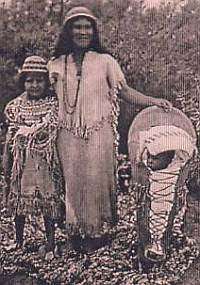Housewife
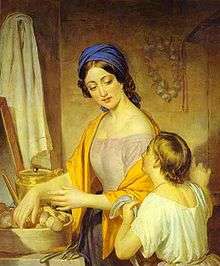
A housewife (also known as a homekeeper) is a woman whose work is running or managing her family's home—caring for her children; buying, cooking, and storing food for the family; buying goods that the family needs in everyday life; housekeeping and maintaining the home; and making clothes for the family—and who is not employed outside the home.[1] A housewife may also be called a stay-at-home mother[2] and a househusband may be called a "male homemaker" or stay-at-home father.
Webster's Dictionary describes a housewife as a married woman who is in charge of her household. The British Chambers's Twentieth Century Dictionary (1901) defined a housewife as: "the mistress of a household; a female domestic manager; a pocket sewing kit".[3] A small sewing kit is sometimes called a "housewife" or "hussif".[4]
Throughout history, women have usually worked for pay, either by contributing to farming and other family-owned businesses or working for other employers. Housewives were common in developed countries only for a few decades during the middle of the 20th century.[5]
Sociology and economics
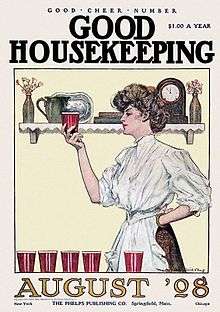
Some feminists[6][7] and non-feminist economists (particularly proponents of historical materialism, the methodological approach of Marxist historiography) note that the value of housewives' work is ignored in standard formulations of economic output, such as GDP or employment figures. Housewives work many unpaid hours a week, often depending on income from their husband's employment for financial support.
Traditional societies
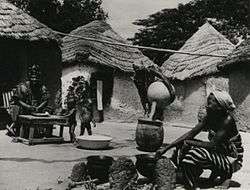
In societies of hunters and gatherers like the traditional society of the Australian aboriginal people, the men hunt animals for meat, and the women gather other foods such as grain, fruit and vegetables. One of the reasons for this division of labor was that it is much easier to look after a baby while gathering fruit than while hunting a fast-moving animal. Even when homes were very simple and there were few possessions, men and women did different jobs.
In rural societies, where the main work is farming, women have also taken care of gardens and animals around the house, generally helping men with heavy work when a job needed to be done quickly, usually because of the season.
Examples of the heavy work that a traditional housewife (homemaker) in a rural society would do are:
- Picking fruit when it was ripe for market
- Planting rice in a paddy field
- Harvesting and stacking grain
- Cutting hay
In rural studies, the word housewife is occasionally used for a woman who does the majority of the chores within a farm's compound as opposed to field and livestock work.
Modern society
A career woman may follow a "mommy track", or a shared earning/shared parenting marriage.
Regarding family size, a study of three Mexican cities came to the result that there was no significant difference in the number of children in housewife families compared to those where women worked outside of the home part or full-time.[8]
It has become more commonplace for the husband and wife to both be employed outside of the home and for both to share in the "housework" and caring for the children.
Full-time homemakers usually share in the income produced by members of the household who are employed; wage-earners working full-time benefit from the unpaid work provided by the housewife; otherwise, the performance of such work (child care, cooking, housecleaning, teaching, transporting, etc.) could be a household expense.[9]Community property states recognize joint ownership of marital property and income, and unless a prenuptial or postnuptial agreement is followed, most marital households in the US operate as a joint financial team and file taxes jointly.
Education
The method, necessity and extent of education of house wives has been debated since at least the 20th century.[10][11][12][13]
Songs about the housewife's lot
The housewife's tasks have often been the subject of songs. Examples include: "The Housewife's Lament" (from the diary of Sarah Price, Ottawa, Illinois, mid 19th century);[14] "Nine Hours a Day" (1871 English song, anonymous); "A Woman's Work is Never Done"[15] or "A Woman Never Knows When her Day's Work is Done"; "The Labouring Woman"; "How Five and Twenty Shillings were Expended in a Week" (English popular songs); "A Woman's Work" (London music hall song by Sue Pay, 1934).[16] "The Housewife's Alphabet", by Peggy Seeger, was issued as a Blackthorne Records single with "My Son".[17]
Housewives by country
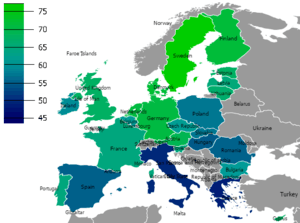
In China
In imperial China (excluding periods of the Tang dynasty), women were bound to homemaking by the doctrines of Confucianism and cultural norms. Generally, girls did not attend school and, therefore, spent the day doing household chores with their mothers and female relatives (for example, cooking and cleaning). In most cases, the husband was alive and able to work, so the wife was almost always forbidden to take a job and mainly spent her days at home or doing other domestic tasks. As Confucianism spread across East Asia, this social norm was also observed in Korea, Japan and Vietnam. As foot binding became common after the Song Dynasty, many women lost the ability to work outside.
After the founding of the Republic of China in 1911, these norms were gradually loosened and many women were able to enter the workforce. Shortly thereafter, a growing number of females began to be permitted to attend schools. Starting with the rule of the People's Republic of China in 1949, all women were freed from compulsory family roles. During the Great Leap Forward and Cultural Revolution, some women even worked in fields that were traditionally reserved for males.
In modern China, housewives are no longer as common, especially in the largest cities and other urban areas. Many modern women work simply because one person's income is insufficient to support the family, a decision made easier by the fact that it is common for Chinese grandparents to watch after their grandchildren until they are old enough to go to school. Nonetheless, the number of Chinese housewives has been steadily rising in recent years as China's economy expands.
In India
In a traditional Hindu family, the head of the family is the Griha Swami (Lord of the House) and his wife is the Griha Swamini (Lady of the House). The Sanskrit words Grihast and Grihasta perhaps come closest to describing the entire gamut of activities and roles undertaken by the homemaker. Grih is the Sanskrit root for house or home; Grihasta and Grihast are derivatives of this root, as is Grihastya. The couple lives in the state called Grihastashram or family system and together they nurture the family and help its members (both young and old) through the travails of life. The woman who increments the family tree (bears children) and protects those children is described as the Grihalakshmi (the wealth of the house) and Grihashoba (the glory of the house). The elders of the family are known as Grihshreshta. The husband or wife may engage in countless other activities which may be social, religious, political or economic in nature for the ultimate welfare of the family and society. However, their unified status as joint householders is the nucleus from within which they operate in society. The traditional status of a woman as a homemaker anchors them in society and provides meaning to their activities within the social, religious, political and economic framework of their world. However, as India undergoes modernisation, many women are in employment, particularly in the larger cities such as Mumbai, Delhi, Kolkata, Chennai, Hyderabad, Bangalore where most women will work. The role of the male homemaker is not traditional in India, but it is socially accepted in urban areas. According to one sociologist's study in 2006, twelve percent of unmarried Indian men would consider being a homemaker according to a survey conducted by Business Today.[19] One sociologist, Sushma Tulzhapurkar, called this a shift in Indian society, saying that a decade ago, "it was an unheard concept and not to mention socially unacceptable for men to give up their jobs and remain at home."[20] However, only 22.7 percent of Indian women are part of the labor force, compared to 51.6 percent of men; thus, women are more likely to be caregivers because most do not work outside the home.[21]
In Korea
North Korea
Until around 1990, the North Korean state required every able-bodied male to be employed by some state enterprise. However, some 30% of married women of working age were allowed to stay at home as full-time housewives (less than in some countries in the same region like South Korea, Japan and Taiwan; more than in the former Soviet Union, Mainland China and Nordic countries like Sweden, and about the same as in the United States[22]). In the early 1990s, after an estimated 900,000-3,500,000 people perished in the North Korean famine, the old system began to fall apart. In some cases women began by selling homemade food or household items they could do without. Today at least three-quarters of North Korean market vendors are women. A joke making the rounds in Pyongyang goes: 'What do a husband and a pet dog have in common?' Answer: 'Neither works nor earns money, but both are cute, stay at home and can scare away burglars.'[23]
In the United Kingdom

Two British magazines for housewives have been published: The Housewife (London: Offices of "The Million", 1886[1900]) and Housewife (London: Hultons, 1939–68).[24]
"On a Tired Housewife" is an anonymous poem about the housewife's lot:
Here lies a poor woman who was always tired,
She lived in a house where help wasn't hired:
Her last words on earth were: "Dear friends, I am going
To where there's no cooking, or washing, or sewing,
For everything there is exact to my wishes,
For where they don't eat there's no washing of dishes.
I'll be where loud anthems will always be ringing,
But having no voice I'll be quit of the singing.
Don't mourn for me now, don't mourn for me never,
I am going to do nothing for ever and ever."[25]
In the United States


About 50% of married US women in 1978 continued to work after giving birth, while in 1997, the number was 61%. The number of housewives increased in the 2000s. With the 2008 financial crisis, a decrease in average income made two incomes more attractive, and the percentage of married US women who kept working after they giving birth increased to 69% by 2009.[26][27] As of 2014, according to the Pew Research Center, more than one in four mothers are stay at home in the United States.
Housewives in America were typical in the middle of the 20th century among middle-class and upper-class white families.[28] Black families, recent immigrants, and other minority groups tended not to benefit from the union wages, government policies, and other factors that led to white wives being able to stay at home during these decades.[28]
A 2005 study estimated that 31 percent of working mothers leave the workplace (for an average of 2.2 years), most often precipitated by the birth of the second child.[29] This gives time to concentrate full-time on child-rearing and to avoid the high cost of child care, particularly through the early years (before school begins at age five). There is considerable variability within the stay-at-home mother population with regard to their intent to return to the paid workforce. Some plan to work from their homes, some will do part-time work, some intend to return to part or full-time work when their children have reached school age, some may increase their skill sets by returning to higher education, and others may find it financially feasible to refrain from entering (or re-entering) the paid workforce. Research has linked feelings of "maternal guilt and separation anxiety" to returning to the workforce.[30]
Similarly, there is considerable variation in the stay-at-home mother's attitude towards domestic work not related to caring for children. Some may embrace a traditional role of housewife, cooking and cleaning in addition to caring for children. Others see their primary role as that of child-care providers, supporting their children's physical, intellectual, emotional, and spiritual development while sharing or outsourcing other aspects of home care.
History
Although men have generally been thought of as the primary breadwinners for families in recent history, the division of labor between men and women in traditional societies required both genders to take an active role in obtaining resources outside the domestic sphere. Prior to discovering agriculture and animal husbandry, predictable food sources were a scarce commodity. To achieve optimal nutrition during this time, it was imperative that both men and women focus their energies on hunting and gathering as many different edible foods as possible to sustain themselves on a daily basis. Lacking the technologies necessary to store and preserve food, it was critical for men and women to seek out and obtain fresh food sources almost continuously. These nomadic tribes used gender differences to their advantage, allowing men and women to use their complementary adaptations and survival strategies to find the most diverse and nutritionally complete foods available. For example, in the context of daily foraging, childcare itself was not a hindrance to women's productivity; rather, performing this task with her children both increased the overall efficiency of the activity (more people participating equals a greater yield of edible roots, berries, nuts and plants), and functioned as an important hands-on lesson in survival skills for each child. By sharing the burden of daily sustenance – and developing specialized gender niches – humans not only ensured their continued survival, but also paved the way for later technologies to evolve and grow through experience.
In the 19th century, more and more women in industrialising countries stopped being homemakers and farm wives and began to undertake paid work in various industries outside the home and away from the family farm, in addition to the work they did at home. At this time many big factories were set up, first in England then in other European countries and the United States. Many thousands of young women went to work in factories; most factories employed women in roles different from those occupied by men. There were also women who worked at home for low wages while caring for their children at the same time.

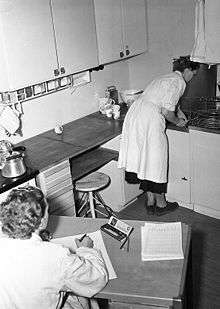
Being a housewife was only realistic among middle-class and upper-class families. In working-class families, it was typical for women to work. In the 19th century, a third to half of married women in England were recorded in the census as working for outside pay, and some historians believe this to be an undercount.[5] Among married couples that could afford it, the wife often managed the housework, gardening, cooking, and children without working outside the home. Women were often very proud to be a good homemaker and have their house and children respectably taken care of. Other women, like Florence Nightingale, pursued non-factory professions even though they were wealthy enough that they did not need the income. Some professions open to women were also restricted to unmarried women, e.g., teaching.
In the early 20th century, both world wars (World War I, 1914–18, and World War II, 1939-45) were fought by men from many countries. (There were also special roles in the armed forces carried out by women, e.g. nursing, transport, etc. and in some countries women soldiers also.) While the men were at war, many of their womenfolk went to work to keep the countries running. Women, who were also homemakers, worked in factories, businesses and farms. At the end of both wars, many men had died, and others had returned injured. Some men were able to return to their previous positions, but some women stayed in the workforce as well. In addition to this surge in women entering the workforce, convenience food and technology were also rising in popularity, both of which saved women time that they may have spent performing domestic tasks, and enabled them to instead pursue other interests.[31]
The governments of Communist countries in the early and middle 20th century such as the Soviet Union and China encouraged married women to keep working after giving birth. There were very few housewives in Communist countries until free market economic reform in the 1990s, which led to a resurgence in the number of housewives. Conversely, in the Western World of the 1950s, many women quit their jobs to be housewives after giving birth. Only 11% of married women in the US kept working after giving birth.[32]
In the 1960s in western countries, it was becoming more accepted for a woman to work until she got married, when it was widely held that she should stop work and be a housewife. Many women believed that this was not treating men and women equally and that women should do whatever jobs they were able to do, whether they were married or not. The Feminine Mystique, a 1963 book by Betty Friedan which is widely credited with sparking the beginning of second-wave feminism in the United States, discussed among other things the lives of housewives from around the United States who were unhappy despite living in material comfort and being married with children.[33][34] At this time, many women were becoming more educated. As a result of this increased education, some women were able to earn more than their husbands. In very rare cases, the husband would remain at home to raise their young children while the wife worked. In 1964 a US stamp was issued honoring homemakers for the 50th anniversary of the Smith-Lever Act.[35][36]
In the late 20th century, in many countries it became harder for a family to live on a single wage. Subsequently, many women were required to return to work following the birth of their children. However, the number of male homemakers began gradually increasing in the late 20th century, especially in developed Western nations. In 2010, the number of male homemakers had reached its highest point of 2.2 million.[37] Though the role is subject to many stereotypes, and men may have difficulties accessing parenting benefits, communities, and services targeted at mothers, it became more socially acceptable by the 2000s.[38] The male homemaker was more regularly portrayed in the media by the 2000s, especially in the United States. However, in some regions of the world the male homemaker remains culturally unacceptable.
Notable Housewives
Examples of notable housewives include:
England
India
The Netherlands
- Fanny Blankers-Koen, Dutch athlete, known as "The Flying Housewife"
United States
See also
- Books
- The Compleat Housewife or Accomplish'd Gentlewoman's Companion, an English cookery book and how-to manual; also the first published cookbook in the United States
- Kitchen Stories
References
- ↑ "Housewife". Macmillan Dictionary.
- ↑ "Home page". StayAtHomeMum.
- ↑ Davidson, Thomas (ed.). Chambers's Twentieth Century Dictionary of the English Language. London: W. & R. Chambers. p. 443.
- ↑ "housewife". Oxford English Dictionary (3rd ed.). Oxford University Press. September 2005. (Subscription or UK public library membership required.)
- 1 2 Wilkinson, Amanda (13 April 2014). "So wives didn't work in the 'good old days'? Wrong". The Guardian. Retrieved 2018-04-23.
- ↑ Luxton, Meg; Rosenberg, Harriet (1986), Through the Kitchen Window: The Politics of Home and Family, Garamond Press, ISBN 978-0-920059-30-2
- ↑ Luxton, Meg (1980), More Than a Labour of Love: Three Generations of Women's Work in the Home, Women's Press, ISBN 978-0-88961-062-0
- ↑ Chant, Sylvia (1991). Women and Survival in Mexican Cities: perspectives on gender, labour markets, and low-income households. Manchester, UK; New York, NY, USA: Manchester University Press Distributed in the USA and Canada by St. Martin's Press. ISBN 0-7190-3443-4. Page 128
- ↑ "What's a Wife Worth?". 17 March 1988. Retrieved 17 Oct 2015.
- ↑ Dement, Alice L. (1960). "Higher Education of the Housewife: Wanted or Wasted?". The Journal of Higher Education. Ohio State University Press. 31 (1 (January)). doi:10.2307/1977571. JSTOR 1977571.
- ↑ "Mummy, I want to be a housewife". Times Higher Education. 26 April 1996. Retrieved 8 May 2016.
- ↑ "Crafting an Educated Housewife in Iran" (PDF).
- ↑ "Highly educated housewives: what an economic waste". The Times. 25 July 2012. Retrieved 8 May 2016.
- ↑ Recorded on: The Female Frolic, Argo ZDA 82 & Seeger, P. Penelope isn't Waiting any More Blackthorne BR 1050
- ↑ Recorded on Staverton Bridge SADISC SDL 266
- ↑ Kathy Henderson et al., comp. (1979) My Song is My Own: 100 women's songs. London: Pluto; pp. 126-28, 142-43
- ↑ New City Songster; vol. 13, Oct. 1977
- ↑ Lena Bernhardtz. "Ekonomiskt oberoende– långt kvar för EU:s kvinnor" (PDF). Välfärd, by Statistics Sweden. February 2013
- ↑ "Life & Times of Indian Men". Business Today. July 29, 2009. Retrieved 2009-07-30.
- ↑ Dias, Raul (June 26, 2006). "Now papas do what mamas did best!". Times of India. Retrieved 2009-07-30.
- ↑ "Asia's women in agriculture, environment and rural production". Archived from the original on 2014-06-30. Retrieved 2009-07-30.
- ↑ a Chinese-English translation web (译言网):Will Chinese women rule the world?
- ↑ Andrei Lankov (a professor in South Korea National University). "Pyongyang's Women Wear the Pants". cuyoo.com (Chinese-English Translate Web.
- ↑ Held by various libraries in the UK; Copac
- ↑ The Penguin Book of Comic and Curious Verse, ed. J. M. Cohen. Harmondsworth: Penguin, 1952; p. 31
- ↑ Employment Characteristics of Families Summary". U.S. Department of Labor. Retrieved 2011-10-22.
- ↑ a Chinese-English translation web (译言网: Will Chinese women rule the world?
- 1 2 Gershon, Livia (2018-03-21). "Seeking a Roadmap for the New American Middle Class". Longreads. Retrieved 2018-04-25.
- ↑ Hewlett, S. A., Luce, C. B., Shiller, P. & Southwell, S. (2005, March). The hidden brain drain: Off-ramps and on-ramps in women’s careers. Center for WorkLife. Policy/Harvard Business Review Research. Report, Product no. 9491. Cambridge, MA: Harvard Business School Publishing Corporation.
- ↑ Rubin, Stacey E., and H. Ray Wooten. "Highly educated stay-at-home mothers: A study of commitment and conflict." The Family Journal 15.4 (2007): 336-345.
- ↑ Maurer, Elizabeth (2017), "How Highly Processed Foods Liberated 1950s Housewives", National Women's History Museum
- ↑ In the kitchen debate in 1959: Nixon said American housewives are happier than the Soviet Union working women
- ↑ "The Feminine Mystique Summary". Enotes.com. Retrieved 2011-02-18.
- ↑ Betty Friedan, Who Ignited Cause in 'Feminine Mystique,' Dies at 85 - The New York Times, February 5, 2006.
- ↑ "Leaving Their Stamp on History". Archived from the original on 2015-09-06.
- ↑ "Arago: Homemakers Issue".
- ↑ Livingston, Gretchen. "Growing Number of Dads Home with the Kids". Pew Research Center’s Social & Demographic Trends Project. Retrieved 2016-03-22.
- ↑ Andrea Doucet, 2006. Do Men Mother? Toronto, ON: University of Toronto Press.
- General
- Allen, Robert, consult. ed. (2003 (et seq)). The Penguin English Dictionary. London, England: Penguin Books. p. 1642. ISBN 0-14-051533-X. Check date values in:
|year=(help)
Further reading
- Swain, Sally (1988) Great Housewives of Art. London: Grafton (reissued by Harper Collins, London, 1995) (pastiches of famous artists showing housewives' tasks, e.g. Mrs Kandinsky Puts Away the Kids' Toys)
- United States
- Campbell, D'Ann (1984). Women at War with America: Private Lives in a Patriotic Era, on World War II
- Ogden, Annegret S. (1987) The Great American Housewife: From Helpmate to Wage Earner, 1776-1986
- Palmer, Phyllis (1990). Housewives and Domestic Servants in the United States, 1920-1945.
- Ramey, Valerie A. (2009), “Time Spent in Home Production in the Twentieth-Century United States: New Estimates from Old Data,” Journal of Economic History, 69 (March 2009), 1–47.
- Tillotson, Kristin (2004) Retro Housewife: a salute to the urban superwoman. Portland, Ore.: Collectors Press ISBN 1-888054-92-1
- Ulrich, Laurel Thatcher (1982). Good Wives: Image and Reality in the Lives of Women in Northern New England, 1650-1750
- Europe
- Draznin, Yaffa Claire (2001). Victorian London's Middle-Class Housewife: What She Did All Day 227pp
- Hardy, Sheila (2012) A 1950s Housewife: Marriage and Homemaking in the 1950s. Stroud: the History Press ISBN 978-0-7524-69-89-8
- McMillan, James F. (1981) Housewife or Harlot: The Place of Women in French Society, 1870-1940 229pp
- Myrdal, Alva & Klein, Viola (1956) Women’s Two Roles: Home and Work. London: Routledge and Kegan Paul
- Robertson, Una A. (1997) Illustrated History of the Housewife, 1650-1950 218pp (on Britain)
- Sim, Alison (1996). Tudor Housewife, (on 1480 to 1609 in England)
External links
| Look up Housewife in Wiktionary, the free dictionary. |
| Look up homemaker in Wiktionary, the free dictionary. |
| Wikimedia Commons has media related to Housewives. |
- Home Economics Archive: Tradition, Research, History (HEARTH), An e-book collection of over 1,000 classic books on home economics spanning 1850 to 1950, created by Cornell University's Mann Library.
- Information and educational materials about 19th century farm wives
